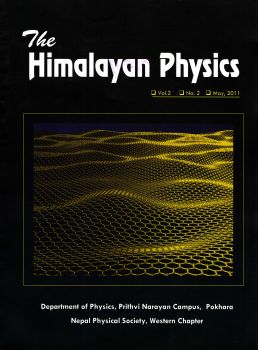Dust Structure Around White Dwarf WD 1003-44 in 60 & 100 μm Iras Survey
DOI:
https://doi.org/10.3126/hj.v2i2.5202Keywords:
White dwarf, Interstellar medium, Flux density, Interstellar dust, Mass of the gasAbstract
We studied the dust structures in 100 micron infrared image around the white dwarf WD 1003-441. The post Asymptotic Giant Branch (AGB) emission of the white dwarf's precursors' wind and the ambient interstellar matter is studied. For this, distribution of the relative flux density is studied and analyzed in the context of the dust color temperature, mass loading trend and the amount of total mass deposited due the interaction in the interstellar medium. The 100 micron far-infrared image is provided by the Groningen server of Infrared Astronomical Satellite (IRAS) survey. The curved emission structure at 100 micron in the region of interest is probably due to the interaction between the ambient interstellar medium and the He-flashes of the parent planetary nebula of the central white dwarf WD 1003-441. This white dwarf is a PG1159 star with 9-11 detected periods and an associated planetary nebula mass ejection. The total mass of the filamentary arc is found to be ~ 8 x 10-2 solar masses, as predicted. The mass loss rate of the post AGB star goes up to 10-5 solar masses per year. It is concluded that the first He-flash occurred at least ~1000 years ago. The amount of total mass around this white dwarf is about ~ 0.134 solar mass. The maximum and minimum dust color temperature around the white dwarf is found to be 19.0 K (±1.5 K) and 22.0 K (±2.0 K), respectively.
Key-Words: White dwarf; Interstellar medium; Flux density; Interstellar dust; Mass of the gas
The Himalayan Physics
Vol.2, No.2, May, 2011
Page: 5-10
Uploaded Date: 31 July, 2011
Downloads
Downloads
Published
How to Cite
Issue
Section
License
This license enables reusers to distribute, remix, adapt, and build upon the material in any medium or format for noncommercial purposes only, and only so long as attribution is given to the creator. If you remix, adapt, or build upon the material, you must license the modified material under identical terms.




